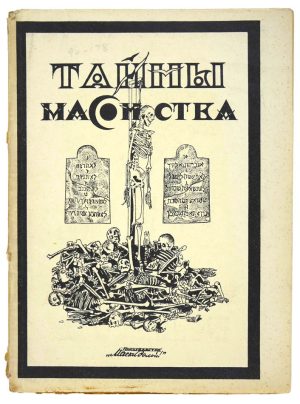Our Notes & References
Shakespeare’s masterpiece first published in Yiddish, with curious references to Soviet details of Jewish life.
A fresh example of this fragile production, inscribed by the translator to Aron Gurshtein, an important figure in the development of Yiddish literature in Eastern Europe. Born in nowadays Ukraine, Gurstein (1895-1941) became a university professor of Yiddish literature in Moscow, Kiev and Odessa. Among various works, he wrote poems, compiled an educational course on Yiddish literature and edited works by Mocher Sforim Mendele and Isaac Leib Peretz. During World War II he joined the “writers’ unit” and was killed in action near Moscow in 1941.
The translator I. Goldberg himself remains mostly unknown, with his first name spelled as “Itsche”, “Yosef” and “Isa” in different catalogues. “The only one to have translated Shakespeare’s work directly from English” (Kahn), Goldberg published eight of Shakespeare’s major plays in Yiddish in 1933-38. He is thought to have be killed “during the Stalinist liquidation of Yiddish culture in the late 1940s and early 1950s” (Kahn). He shouldn’t be confused with the American writer, literary scholar and publisher Iche Goldberg.
Goldberg’s translation is notable for its original ‘Soviet’ Yiddish spelling and the language “reflecting the specific cultural context of Jewish life in the early Soviet Union, which manifests itself in a tension between modernising Soviet ideology and traditional Eastern European Jewish elements”; it is intentionally accessible for the broader audience, printed “with few complex wordplays” (Kahn). In a footnote (in Belorussian in Yiddish transcription) at the end of the book, Goldberg explains the logic of his translation and the original meaning of certain non-obvious English speech patterns.
The translation was most likely commissioned by the State for the new Jewish theatres, primarily the landmark Moscow State Jewish Theatre (GOSET) or the Belorussian State Jewish Theatre (BELGOSET): the latter was established in the late 1920s in the newly-formed Soviet Republic of Belarus, a flowering place of Eastern European Jewish culture in the early 20th century and home to the world-famous modernists Marc Chagall, Chaïm Soutine and Leon Bakst among many others.
By the early 1930s, BELGOSET had a number of popular productions of modern Soviet dramatists, Yiddish classics and Shakespeare’s plays, particularly ‘The Merchant of Venice’ and ‘The Merry Wives of Windsor’: the English playwright was popular in Jewish theatres “primarily because his material offered a wide range of interpretations, as well as the scope and freedom that a developing national culture needed for its expansion” (Gaevskii).
Because of the Nazi occupation of Belarus, of the poor documentation of the theatres activities and staging, and of the later Stalinist crackdown on Jewish and Yiddish cultures in the 1940s and 50s, it is unclear whether a production of ‘Romeo and Juliet’ took place in these Jewish theatres.
Undoubtedly, these factors also played a role on the scarcity of the publication: we could not find any copy offered on the market in recent years (or even decades, for Western auctions). Worldcat locates 6 holdings worldwide, apparently none in the UK (YIVO Institute, Jewish Theological Seminary of America, NYPL, Harvard, LoC, and the National Library of Israel which obtained its copy through the “Diaspora Treasures project after several copies of this book were looted by the Nazis”). We should add copies we are able to trace: at the National Library of Belarus and in the St. Petersburg RNB.
This edition is apparently the first published translation of Romeo and Juliette in Yiddish: since the play seems to have been performed in Yiddish as early as 1894, there must have been at least one translation before Goldberg’s; but we could not find trace of any such publication before this 1935 Minsk edition.
Provenance
Aron Gurshtein (inscription in Belarusian in Yiddish transcription on the front flyleaf).
Bibliography
J. Berkowitz, Shakespeare on the American Yiddish Stage, Iowa City: University of Iowa Press, 2002.
Vadim Gaevskii, “Kto postavil ‘Korolia Lira’?”, Colta, 2019.
V. Ivanov, GOSET: politika i iskusstvo: 1919-1928, Moskva, GITIS, 2007.
Lily Kahn, “Soviet Framework: Y. Goldberg’s 1935 Yiddish Othello, Shakespeare”, Jewish Cultural Traditions within a Modernising Early, 18:1, 2022, pp. 62-82.
Leonard Prager, “Shakespeare in Yiddish”, Shakespeare Quarterly, vol. 19, no. 2, 1968, pp. 149–58.
Physical Description
Octavo (22.7 x 15.3 cm). 142 incl. title, [2] pp. errata and printing details.
Binding
Original publisher’s printed boards, upper cover with the author’s portrait, flat spine plain.
Condition
The fragile binding a bit rubbed and bumped, lower hinge with small splits, small scratch to lower cover; title with a couple of light spots, two very small ink spots to block edge otherwise immaculate.
















![Image for I. SAPIR. Sionizm [ZIonism]. First edition, Vilnius, 1903. #2](https://www.pyrarebooks.com/wp-content/uploads/2024/02/92_1-300x420.jpg)